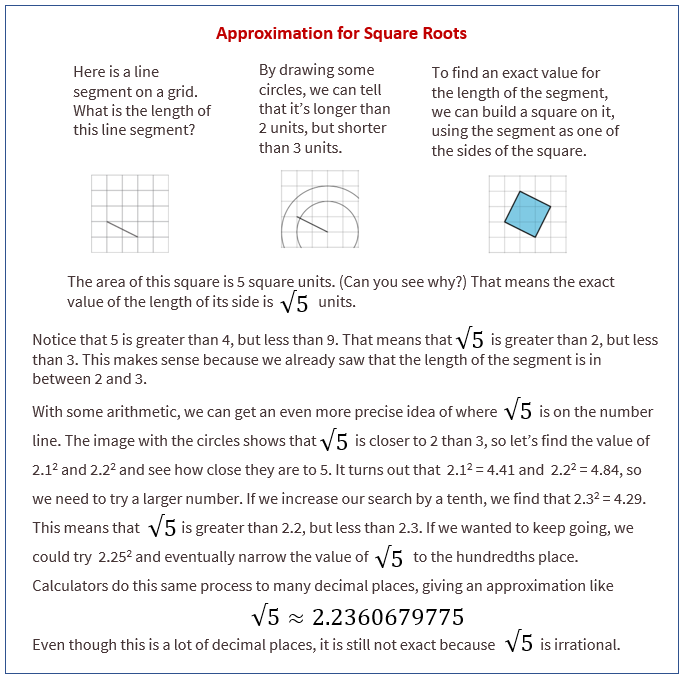Illustrative Mathematics Grade 8, Unit 8, Lesson 4: Square Roots on the Number Line
Learning Targets:
- I can find a decimal approximation for square roots.
- I can plot square roots on the number line.
Related Pages
Illustrative Math
Grade 8
Lesson 4: Square Roots on the Number Line
Let’s explore square roots.
Illustrative Math Unit 8.8, Lesson 4 (printable worksheets)
Lesson 4 Summary
The following diagram shows how to find a decimal approximation for square roots.

Lesson 4.1 Diagonals
- What is the exact length of the line segment?
- Find a decimal approximation of the length.
Lesson 4.2 Squaring Lines
- Estimate the length of the line segment to the nearest tenth of a unit (each grid square is 1 square unit).
- Find the exact length of the segment.
Lesson 4.3 Square Root of 3
Diego said that he thinks that √3 ≈ 2.5
- Use the square to explain why 2.5 is not a very good approximation for √3. Find a point on the number line that is closer to √3. Draw a new square on the axes and use it to explain how you know the point you plotted is a good approximation for √3.
- Use the fact that √3 is a solution to the equation x2 = 3 to find a decimal approximation of √3 whose square is between 2.9 and 3.1.
Are you ready for more?
A farmer has a grassy patch of land enclosed by a fence in the shape of a square with a side length of 4 meters. To make it a suitable home for some animals, the farmer would like to carve out a smaller square to be filled with water, as in the figure.
What should the side length of the smaller square be so that half of the area is grass and half is water?
-
Show Answer
Area of larger square is 4 · 4 = 16
16 ÷ 2 = 8
Length of smaller square = √8 = 2√2
Lesson 4 Practice Problems
- a. Find the exact length of each line segment. b. Estimate the length of each line segment to the nearest tenth of a unit. Explain your reasoning.
- Plot each number on the x-axis: √16, √35, √66. Consider using the grid to help.
- Use the fact that is a solution to the equation to find a decimal approximation of whose square is between 6.9 and 7.1.
- Graphite is made up of layers of graphene. Each layer of graphene is about 200 picometers, or meters, thick. How many layers of graphene are there in a 1.6-mm-thick piece of graphite? Express your answer in scientific notation.
- Here is a scatter plot that shows the number of assists and points for a group of hockey players. The model, represented by , is graphed with the scatter plot.
a. What does the slope mean in this situation?
b. Based on the model, how many points will a player have if he has 30 assists? - The points (12,23) and (14,45) lie on a line. What is the slope of the line?
The Open Up Resources math curriculum is free to download from the Open Up Resources website and is also available from Illustrative Mathematics.
Try out our new and fun Fraction Concoction Game.
Add and subtract fractions to make exciting fraction concoctions following a recipe. There are four levels of difficulty: Easy, medium, hard and insane. Practice the basics of fraction addition and subtraction or challenge yourself with the insane level.

We welcome your feedback, comments and questions about this site or page. Please submit your feedback or enquiries via our Feedback page.